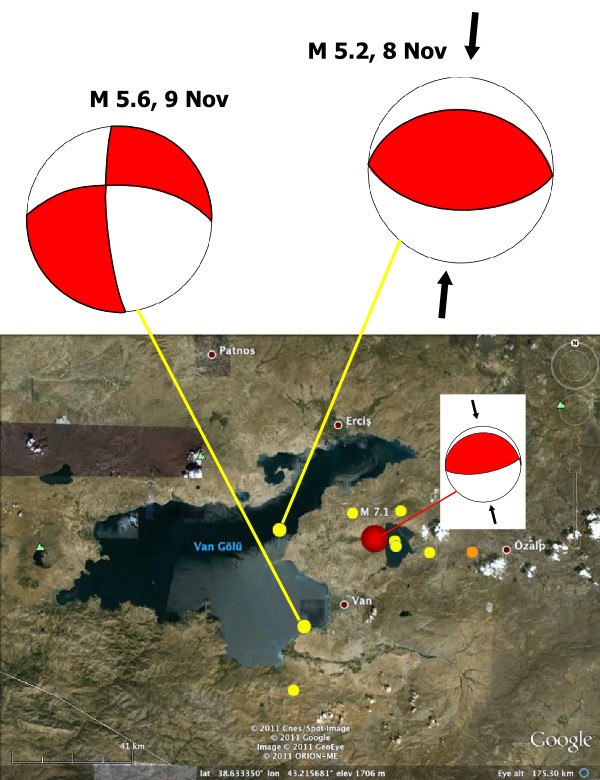![]() Almost a fortnight after a magnitude 7.1 earthquake shook Eastern Turkey, the region continues to suffer from aftershocks, and there were two pretty big ones earlier this week: a magnitude 5.2 on Tuesday, and then a magnitude 5.6 on Wednesday. As this rather harrowing CCTV footage shows, the shaking from the latter quake was powerful enough to push more buildings past the point of collapse, killing at least 13 people.
Almost a fortnight after a magnitude 7.1 earthquake shook Eastern Turkey, the region continues to suffer from aftershocks, and there were two pretty big ones earlier this week: a magnitude 5.2 on Tuesday, and then a magnitude 5.6 on Wednesday. As this rather harrowing CCTV footage shows, the shaking from the latter quake was powerful enough to push more buildings past the point of collapse, killing at least 13 people.
Like the original shock, the focal mechanism for the smaller M 5.2 tremor on Tuesday indicates north-south compression on an east-west oriented thrust fault (a primer on interpreting focal mechanisms). It is 20-30 km directly west of the main shock, so potentially occurred on the same fault that originally ruptured a couple of weeks ago. In contrast, the more damaging M 5.6 quake was 30-40 km to the southwest, and has a strike-slip focal mechanism.

Focal mechanisms for the two M 5+ aftershocks of the Van earthquake in Eastern Turkey this week. Red circle and inset focal mechanism are for the M7.1 main shock.
As I discussed in my original post, and talked about in a bit more detail on the Scientific American guest blog, tectonics in this region are complicated, due to the transition between continental collision further east in Iran, and the strike-slip ‘escape’ tectonics that drive activity on the Anatolian Faults further to the west in Turkey. So we might expect to be seeing thrust and strike-slip earthquakes mixed up with each other. However,the precise type of deformation that the focal mechanism represents is a little unclear in this instance. Every focal mechanism has two ‘focal planes’, which represent the two possible ways the ground could have moved in the initial rupture to produce the first-motion patterns seen on the global seismograph network. Without additional information, such as a surface rupture or knowledge of regional structure, it is sometimes difficult to know which of the focal planes actually corresponds to the fault.
In the case of Wednesdays earthquake, the focal mechanism tells us that it was due to right lateral strike-slip on a fault that runs from east to west, or left-lateral strike-slip on a fault that runs from north to south.

Two possible interpretations of the M 5.6 aftershock on Wednesday, depending on which of the focal planes is the fault plane.
The first option, an east-west running strike-slip fault, is more consistent with the overall regional deformation (Turkey moving west). But the main shock last month tells us that this particular area is also experiencing north-south compression, which could be accommodated by strike-slip on a north-south oriented fault just as easily as thrusting on an east-west trending fault. This ambiguity is a useful reminder of the limits of studying tectonics from a distance: you can usually see the big picture, but without knowledge of local geology and structure you can’t always unravel the detail.



Nice plan for content warnings on Mastodon and the Fediverse. Now you need a Mastodon/Fediverse button on this blog.